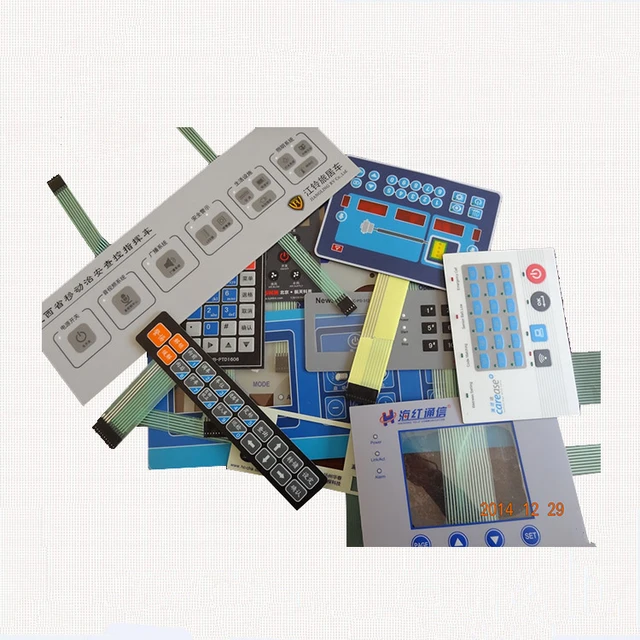Understanding Membrane Changes: The Key to Trusted and long lasting Controls

What Are Membrane Layer Switches?
Membrane layer switches are a sophisticated service in the world of interface modern technology, combining performance and design perfectly. These gadgets act as a user interface between individuals and electronic systems, incorporating numerous parts right into a small style. Generally constructed from versatile, thin layers of materials, membrane layer buttons are developed to reply to touch, allowing users to interact with machinery and electronic tools efficiently.
The main aspects of a membrane switch include a published circuit layer, visuals overlay, and a spacer layer that protects against unplanned activation. The visuals overlay can be customized to reflect brand identification or user preferences, enhancing looks while ensuring functionality. Membrane switches are typically utilized in numerous applications, consisting of medical gadgets, customer electronic devices, and commercial devices, owing to their longevity and resistance to environmental aspects such as wetness and dirt.
One of the vital benefits of membrane buttons is their capability to withstand deterioration, making them ideal for high-traffic settings. Additionally, they are lightweight and call for marginal area, permitting ingenious styles in item growth. On the whole, membrane switches over stand for a effective and functional selection for modern-day electronic interfaces, marrying technology with user-centric style principles.
Exactly How Membrane Switches Job
The operation of membrane switches over hinges on an easy yet effective device that converts customer input right into digital signals. These buttons include several layers, usually consisting of a graphic overlay, a spacer layer, and a circuit layer. When an individual presses the button, the top layer deforms, allowing a conductive component in the circuit layer to reach an equivalent conductive pad on the underside of the graphic overlay. This get in touch with shuts the circuit and sends out an electronic signal to the device, indicating that the switch has actually been triggered.
The design of membrane switches can vary, yet they usually incorporate domes or tactile aspects to give comments to the user, enhancing the total experience - membrane switch. The products made use of in membrane layer buttons, such as polyester or polycarbonate, add to their longevity and resistance to ecological variables, including moisture and dust. Moreover, the published circuits are normally encapsulated, which protects them from wear and tear gradually.
Benefits of Membrane Buttons

Additionally, membrane switches are understood for their durability. Constructed from robust materials, they are resistant to dirt, dampness, and physical wear, which significantly extends their life expectancy compared to standard mechanical switches. This toughness makes them specifically suitable for high-traffic environments and applications requiring longevity.
Another significant advantage is the right here convenience of cleansing and upkeep. The smooth surface area of membrane layer changes reduces dust accumulation and is typically unsusceptible spills, making them suitable for settings that require frequent sanitization.
Moreover, membrane layer buttons use a streamlined profile, leading to a thinner layout that can be incorporated into numerous devices without including mass. This function not only boosts the visual appeal yet likewise adds to a more ergonomic item style.
Applications of Membrane Buttons
Easy to use and versatile, membrane layer switches find applications throughout a variety of sectors, including medical gadgets, customer electronics, and commercial devices. In the clinical field, these buttons are essential to devices such as analysis equipment, person tracking systems, and infusion pumps, where dependability and ease of cleansing are essential. Their capacity to endure harsh atmospheres and maintain see post functionality makes them excellent for such applications.

In consumer electronic devices, membrane switches are made use of in items like microwaves, cleaning devices, and remotes - membrane switch. Their sleek style permits intuitive interface, boosting the general customer experience while offering longevity and resistance to damage
Commercial devices additionally takes advantage of membrane switches, especially in control panels for equipment and automation systems. These switches use defense versus dust and moisture, making sure regular efficiency in challenging atmospheres. Furthermore, their customizable functions enable makers to customize them to particular functional requirements, boosting performance and capability.
Selecting the Right Membrane Layer Switch Over
When picking a membrane layer switch, it is important to consider various elements that influence performance and suitability for specific applications. The key factors here are the findings to consider consist of environmental conditions, responsive responses, longevity, and style specs.
First, evaluate the operating environment; switches exposed to dampness, chemicals, or severe temperatures require details products to guarantee long life and performance. Next, evaluate the demand for tactile feedback. Relying on customer communication, some applications may take advantage of a tactile response to validate activation, while others may prefer a non-tactile layout for aesthetic reasons.
Sturdiness is another critical variable; membrane buttons must be developed to withstand regular use, effects, and abrasion. Ensure the selected button can endure the anticipated lifecycle, particularly in high-usage circumstances.

Verdict
In final thought, membrane layer switches over serve as crucial elements in the style of dependable and long lasting control systems throughout various markets. The convenience of membrane changes permits for customized solutions that satisfy details functional needs, strengthening their value in modern technology.
Membrane changes stand for a critical element of contemporary user interface style, mixing capability with resilience in various applications.Membrane switches are an advanced option in the world of customer interface technology, combining functionality and design perfectly. Normally created from adaptable, slim layers of products, membrane layer buttons are created to react to touch, making it possible for customers to engage with equipment and digital gadgets effectively.
The style of membrane layer buttons can differ, however they usually include domes or responsive aspects to offer comments to the user, enhancing the overall experience.In verdict, membrane layer changes serve as vital parts in the design of long lasting and trustworthy control systems throughout different sectors.
Comments on “Membrane Switch: A Comprehensive Guide to Its Uses and Applications”